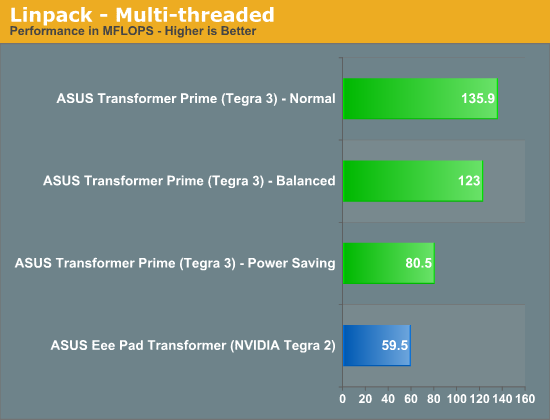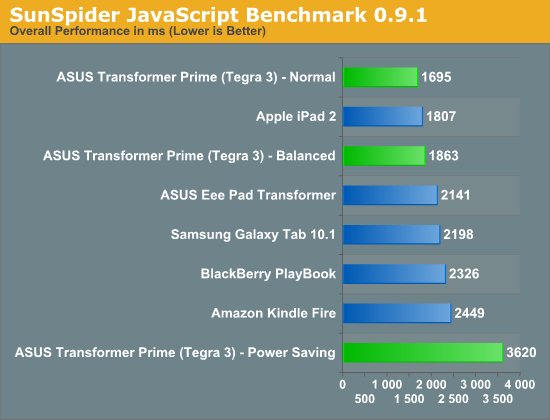ASUS Eee Pad Transformer Prime & NVIDIA Tegra 3 Review
by Anand Lal Shimpi on December 1, 2011 1:00 AM ESTCPU Performance
The big news with Tegra 3 is that you get four ARM Cortex A9 cores with NEON support instead of just two (sans NEON) in the case of the Tegra 2 or most other smartphone class SoCs. In the short period of time I had to test the tablet I couldn't draw many definitive conclusions but I did come away with some observations.
Linpack showed us healthy gains over Tegra 2 thanks to full NEON support in Tegra 3:


As expected, finding applications and usage models to task all four cores is pretty difficult. That being said, it's not hard to use the tablet in such a way that you do stress more than two cores. You won't see 100% CPU utilization across all four cores, but there will be a tangible benefit to having more than two. Whether or not the benefit is worth the cost in die area is irrelevant, it only means that NVIDIA (and/or its partners) have to pay more as the price of the end product to you is already pretty much capped.


The bigger benefit I saw to having four cores vs. two is that you're pretty much never CPU limited in anything you do when multitasking. Per core performance can always go up but I found myself bound either by the broken WiFi or NAND speed. In fact, the only thing that would bring the Prime to a halt was if I happened to be doing a lot of writing to NAND over USB. Keyboard and touch interrupts were a low priority at that point, something I hope to see addressed as we are finally entering the era of performance good enough to bring on some I/O crushing multitasking workloads.

Despite having many cores at its disposal, NVIDIA appears to have erred on the side of caution when it comes to power consumption. While I often saw the third and fourth cores fire up when browsing the web or just using the tablet, NVIDIA did a good job of powering them down when their help wasn't needed. Furthermore, NVIDIA also seems to prefer running more cores at lower voltage/frequency settings than fewer cores at a higher point in the v/f curve. This makes sense given the non-linear relationship between voltage and power.
From a die area perspective I'm not entirely sure having four (technically, five) A9 cores is the best way to deliver high performance, but without a new microprocessor architecture it's surely more efficient than just ratcheting up clock speed. I plan on providing a more thorough look at Tegra 3 SoC performance as I spend more time with a fixed Prime, but my initial impressions are that the CPU performance isn't really holding the platform back.










204 Comments
View All Comments
steven75 - Saturday, December 3, 2011 - link
If you want the best tablet for your grandmother, shouldn't you be making decisions based on her needs and not yours?SydneyBlue120d - Thursday, December 1, 2011 - link
Anand, do You think the Dual Core Snapdragon S4 will be able to beat the Quad core Tegra3? Thnx :)A5 - Thursday, December 1, 2011 - link
As with any core-based discussion, it depends on what you're doing.tipoo - Thursday, December 1, 2011 - link
Yeah, depends on how well optimized applications are for multicore. In most cases I'd bet a fast dual core would beat a slower quad.tipoo - Thursday, December 1, 2011 - link
If I'm not mistaken, Honeycomb doesn't have GPU acceleration on all windows by default like ICS will, and ICS will also have better multicore optimization. I'd like to see some benchmarks on the Prime after ICS.HighTech4US - Thursday, December 1, 2011 - link
I second this request.SydneyBlue120d - Thursday, December 1, 2011 - link
Another question: Any info about the audio chip? I mean: Can we expect wolfson Galaxy S quality? Tnx!Willhouse - Thursday, December 1, 2011 - link
Why is the cost drifting up instead of down? The whole appeal of the original transformer was that is was "comparable" in quality but $100 less than other quality tablets. Those of us who are mildly interested in tablets, but can't stomach the costs, aren't going to rush out to buy this even if it is the best android tablet. Is there a large tablet enthusiast market that needs the absolute best hardware at all times?Sorry if this was mentioned - I was immediately outraged and didn't read all the comments.
Roland00Address - Thursday, December 1, 2011 - link
The Transformer Prime has 32 and 64gb for the internal storage (with micro sd expansion). Note the base model is not 16gb.32gb
499 Transformer Prime
599 Ipad 2
64gb
599 Transformer Prime
699 Ipad 2.
--------------------
If you want to get a tegra 2 tablet cheaper than 400 you should be looking at the winter sales on such products, it may not be the asus transformer but it is stlil a tegra 2 honeycomb tablet. No one is going to release a better product cheaper than there old gen, in a cut throat market with decreasing margins unless that product has serious competition.
Kegetys - Thursday, December 1, 2011 - link
Is it correct that it doesn't come with 3G (or 4G) connectivity at all? I'm so used to being able to be connected almost anywhere with both my cellphone and laptop with zero hassle that being restricted to WLAN only would be quite a limitation for a mobile device like this.Also, seriously Asus, why cant you have those beautiful IPS screens available for laptops as well?